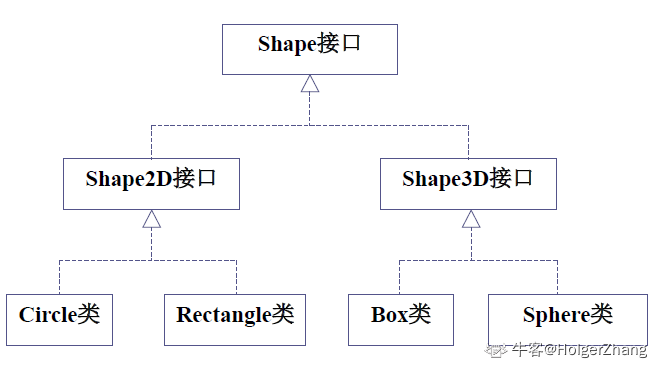接口可以看做是一个“纯”抽象类,它只提供一种形式,并不提供实现。
接口中可以规定方法的原型 :方法名、参数列表以及返回类型 ,但不规定方法主体 ;也可以包含基本数据类型 的数据成员,但它们都默认为static和final。
是面向对象的一个重要机制
是继承多个设计
建立了类和类之间的“协议”:
将类根据其实现的功能分组用接口 代表,而不必顾虑它所在的类继承层次 ;这样可以最大限度地利用动态绑定,隐藏实现细节
实现不同类之间的常量 共享
接口允许我们在看起来不相干的对象之间定义共同行为,如下UML类图所示:
1 2 3 [接口修饰符] interface 接口名称 [extends 父接口名]{ }
注意:
接口的数据成员一定要有初值 ,且此值将不能再更改,可以省略final关键字,即接口中每一个方法是隐式抽象 的,接口中的方法被隐式的指定为 public abstract(只能是public abstract,其他修饰符都会报错);
接口中的方法必须是抽象方法 ,不能有方法体,可以省略public及abstract关键字,即接口中的变量会被隐式的指定为public static final变量(并且只能是public,用private修饰会报编译错误)。
接口不能用于实例化对象。
接口没有构造方法。
接口中所有的方法必须是抽象方法 ,只能由实现接口的类来实现接口中的方法。
接口不能包含成员变量,除了static和final变量。
接口不是被类继承了,而是要被类实现 。
接口支持多继承 。
抽象类中的方法可以有方法体,就是能实现方法的具体功能,但是接口中的方法不行。
注:JDK 1.8 以后,接口里可以有静态方法和方法体了。
抽象类中的成员变量可以是各种类型的,而接口中的成员变量只能是public static final类型的。
一个类只能继承一个抽象类,而一个类却可以实现多个接口。
**强调:**接口有以下特性
接口是隐式抽象的,当声明一个接口的时候,不必使用abstract关键字。
接口中每一个方法也是隐式抽象的,声明时同样不需要abstract关键字。
接口中的方法都是公有的。
例:接口声明
声明一个接口Shape2D,包括π和计算面积的方法原型
1 2 3 4 interface Shape2D final double pi = 3.14 ; public abstract double area () }
在接口的声明中,允许省略一些关键字,也可声明如下
1 2 3 4 interface Shape2D double pi = 3.14 ; double area () }
不能用new运算符直接产生接口对象。
利用接口设计类的过程,称为接口的实现,使用implements关键字,语法如下:
1 2 3 4 public class 类名称 implements 接口名称 }
注意:
必须实现接口中的所有方法;
来自接口的方法必须声明成public。
例:实现接口 Shape2D
1 2 3 4 5 6 7 8 9 10 11 12 13 14 15 16 17 18 19 20 21 22 23 24 25 26 27 28 class Circle implements Shape2D double radius; public Circle (double r) radius = r; } public double area () return (pi * radius * radius); } } class Rectangle implements Shape2D int length, width; public Rectangle (int l, int w) length = l; width = w; } public double area () return (width * length); } } public class InterfaceTester public static void main (String args[]) Rectangle rect = new Rectangle(5 , 6 ); System.out.println("Area of rect = " + rect.area()); Circle cir = new Circle(2.0 ) System.out.println("Area of cir = " + cir.area()); } }
运行结果:
1 2 Area of rect = 30.0 Area of cir = 12.56
Java不允许一个类有多个超类
一个类可以实现多个接口,通过这种机制可实现对设计的多重继承。
实现多个接口的语法如下:
1 2 3 4 [类修饰符] class 类名称 implements 接口1, 接口2, … }
强调:
重写接口中声明的方法时,需要注意以下规则:
类在实现接口的方法时,不能抛出强制性异常 ,只能在接口中,或者继承接口的抽象类中 抛出该强制性异常。
类在重写方法时要保持一致的方法名 ,并且应该保持相同或者相兼容的返回值类型 。
如果实现接口的类是抽象类 ,那么就没必要实现该接口的方法 。
在实现接口的时候,也要注意一些规则:
一个类只能继承一个类 ,但是能实现多个接口 。
一个接口能继承另一个接口,这和类之间的继承比较相似。
接口的灵活性就在于“规定了一个类必须做什么,而不管你如何做”。
我们可以定义一个接口类型的引用变量 来引用实现接口的类的对象 ,当这个引用来调用方法时,它会根据实际引用的类的实例来判断具体调用哪个方法 (实现了方法在运行时的动态绑定)。
例:
1 2 3 4 5 6 7 8 9 public class VariableTester public static void main (String args[]) Shape2D var1, var2; var1 = new Rectangle(5 , 6 ); System.out.println("Area of var1 = " + var1.area()); var2 = new Circle(2.0 ); System.out.println("Area of var2 = " + var2.area()); } }
运行结果:
1 2 Area of rect = 30.0 Area of cir = 12.56
接口可通过扩展的技术派生出新的接口
原来的接口称为超接口(super interface);
派生出的接口称为子接口(sub interface)。
一个接口能继承另一个接口,和类之间的继承方式比较相似。接口的继承使用extends关键字,子接口继承父接口的方法。
在Java中,类的多继承是不合法,但接口允许多继承。
在接口的多继承中extends关键字只需要使用一次,在其后跟着继承接口。
接口扩展的语法:
1 2 3 interface 子接口的名称 extends 超口的名称1, 超接口的名称2, … }
注意:实现一个接口的类也必须实现其超接口。
例:Shape 是超接口,Shape2D 与 Shape3D 是其子接口。Circle 类及 Rectangle 类实现接口 Shape2D, 而 Box 类及 Sphere 类实现接口 Shape3D。关系可由如下UML类图表示:
代码如下:
1 2 3 4 5 6 7 8 9 10 11 12 13 14 15 16 17 18 19 20 21 22 23 24 25 26 27 28 29 30 31 32 33 34 35 36 37 38 39 40 41 42 43 44 45 46 47 48 49 50 51 52 53 54 55 56 57 58 59 60 61 62 63 64 65 66 67 68 69 70 71 72 73 74 75 76 77 78 79 80 81 82 83 84 85 86 87 88 89 90 91 92 93 94 95 96 97 98 99 100 101 102 103 104 105 106 107 108 109 110 111 112 113 114 115 116 117 118 119 120 121 122 123 124 125 126 127 interface Shape double pi = 3.14159 ; void setColor (String str) } interface Shape2D extends Shape double area () } interface Shape3D extends Shape double superficialArea () double volume () } class Circle implements Shape2D double radius; String color; public Circle (double r) radius = r; color = "white" ; System.out.println("New Circle: radius = " + radius); } public double area () return (pi * radius * radius); } public void setColor (String str) color = str; System.out.println("color = " + color); } } class Rectangle implements Shape2D int length, width; String color; public Rectangle (int l, int w) length = l; width = w; color = "white" ; System.out.println("New Rectangle: length = " + length + ", width = " + width); } public double area () return (width * length); } public void setColor (String str) color = str; System.out.println("color = " + color); } } class Box implements Shape3D int length, width, height; String color; public Box (int l, int w, int h) length = l; width = w; height = h; color = "white" ; System.out.println("New Rectangle: length = " + length + ", width = " + width + ", height = " + height); } public double superficialArea () return (2 * length * width + 2 * height * width + 2 * length * height); } public double volume () return (length * width * height); } public void setColor (String str) color = str; System.out.println("color = " + color); } } class Sphere implements Shape3D double radius; String color; public Sphere (double r) radius = r; color = "white" ; System.out.println("New Sphere: radius = " + radius); } public double superficialArea () return (4 * pi * radius * radius); } public double volume () return (4 * pi * radius * radius * radius / 3 ); } public void setColor (String str) color = str; System.out.println("color = " + color); } } public class ExtendsInterfaceTester public static void main (String[] args) Circle cir; cir = new Circle(2.0 ); cir.setColor("blue" ); System.out.println("Area of Circle cir is " + cir.area()); System.out.println(); Rectangle rec; rec = new Rectangle(5 , 6 ); rec.setColor("red" ); System.out.println("Area of Rectangle rec is " + rec.area()); System.out.println(); Box box; box = new Box(3 , 4 , 5 ); box.setColor("green" ); System.out.println("Superficial Area of Box box is " + box.superficialArea()); System.out.println("Volume of Box box is " + box.volume()); System.out.println(); Sphere sph; sph = new Sphere(15.0 ); sph.setColor("yellow" ); System.out.println("Superficial Area of Sphere sph is " + sph.superficialArea()); System.out.println("Volume of Sphere sph is " + sph.volume()); System.out.println(); } }
运行结果:
1 2 3 4 5 6 7 8 9 10 11 12 13 14 15 16 17 18 New Circle: radius = 2.0 color = blue Area of Circle cir is 12.56636 New Rectangle: length = 5, width = 6 color = red Area of Rectangle rec is 30.0 New Rectangle: length = 3, width = 4, height = 5 color = green Superficial Area of Box box is 94.0 Volume of Box box is 60.0 New Sphere: radius = 15.0 color = yellow Superficial Area of Sphere sph is 2827.431 Volume of Sphere sph is 14137.155
最常用的继承接口是没有包含任何方法的接口。
标记接口 是没有任何方法和属性的接口。它仅仅表明它的类属于一个特定的类型 ,供其他代码来测试允许做一些事情。
标记接口作用 :使对象拥有某个或某些特权。(就是给某个对象打个标、盖个戳)
例如:java.awt.event包中的MouseListener接口继承的java.util.EventListener接口定义如下:
1 2 package java.util;public interface EventListener
标记接口主要用于以下两种目的 :


